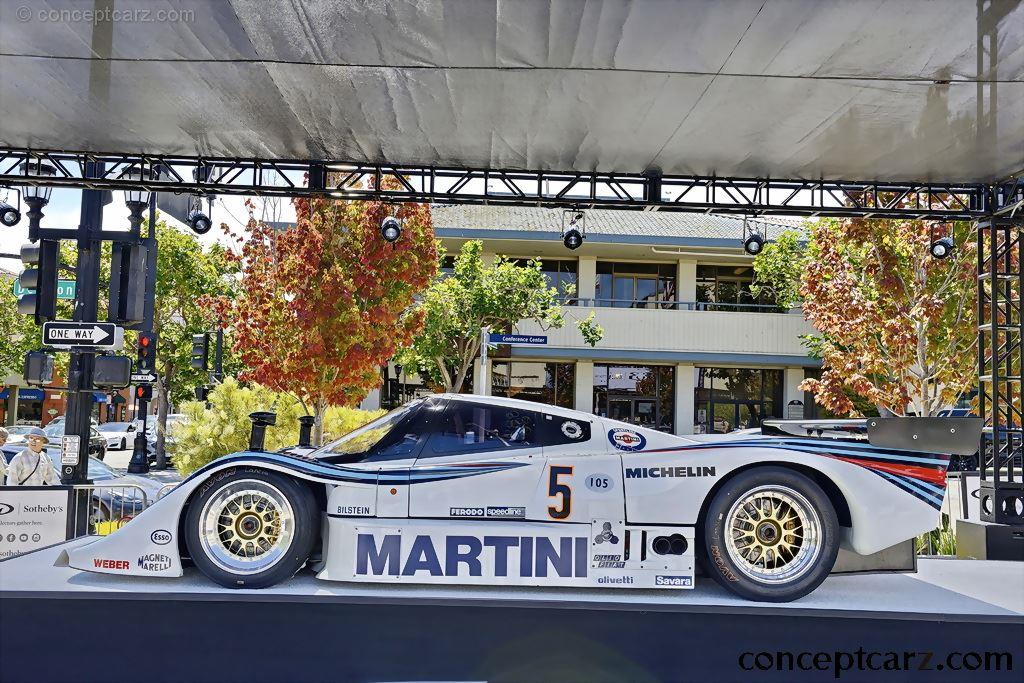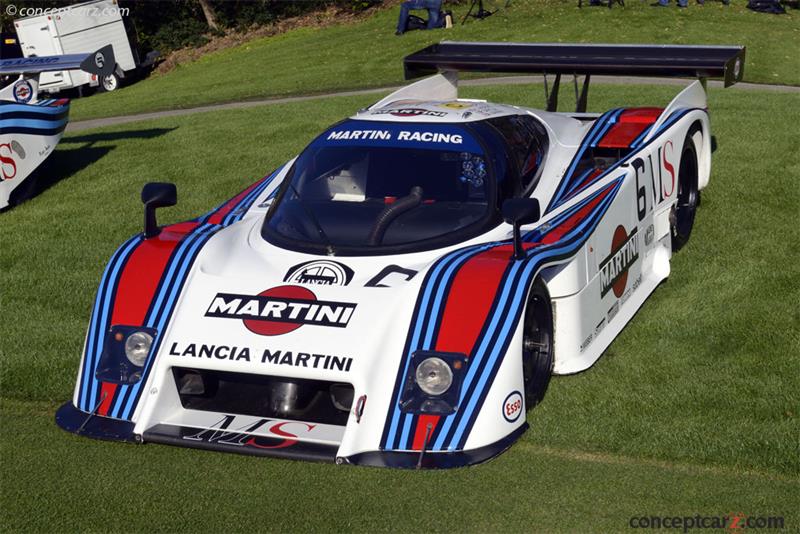Lancia's re-introduction into the world of racing began with their 1.4 liter turbocharged four-cylinder racer dubbed the Beta Monte Carlo. With its engine size, it qualified for the under-two-liter category of the Group 5 class. Its potential was immediately realized, and it dominated the 1979 through 1981 seasons, winning the class World Championship. For the 1982 season, Lancia wanted to showcase their potential in an even more competitive class. 
Coupe
Chassis #: 002
View info and history
Auction entries : 1Lancia created a spyder-bodied, four-cylinder racer called the LC1. It was built to Group C class specifications which focused heavily on limiting the amount of fuel used throughout the race. The four-cylinder engine was relatively fuel efficient, but it was seriously lacking in power when compared with its competition, such as the Porsche 956. Lancia did not have an engine to combat its competition, so it turned to Ferrari, which supplied a 308 QV variant. The DOHC V8 engine was modified to displace 2.65 liters, and two KKK turbochargers were adopted. The legendary turner, Abarth, was tasked with performing the engine modifications. The 2.65 displacement size was chosen so that it would be eligible for competing at the Indianapolis 500. The engine was matted to a Hewland five-speed manual gearbox with disc brakes at all four wheels. The chassis was designed by Giampaolo Dallara and comprised of carbon-fibre and kevlar. Ground effects were formed to create additional downforce. A radiator was used to cool the engine, while intercoolers kept the turbo at a reasonable temperature. The LC2 was finished in a white color with Martini stripes. Red and blue stripes were adorned over the front wheel wells.At the 1983 Le Mans race, Lancia entered three examples of their LC2 racers. The vehicles proved their capability with speeds that rivaled those of the Porsche 956's. During the first few hours of the race, it appeared as though Lancia might emerge from the race victorious. This would not be the case; by the thirteenth hour, all three racers had retired due to various mechanical difficulties. Porsche went on to get the first eight places, humiliating the rest of the field.
For the following LeMans race, Lancia came even more prepared. Their engine was improved to displace even more horsepower while achieving better fuel economy; even the aerodynamics had been improved from the prior year. Lancia entered two works cars for the 1984 LeMans endurance race. Since Porsche had chosen to boycott the race due to problems with the event's organizers, Lancia was poised to take home the checkered flag. During qualifications, Lancia secured both cars in the front row. During the first few hours of the race, the Lancia's were virtually un-contended. Bob Wollek recorded the fastest lap in his LC2, and the work's cars were on their way to victory. Unfortunately, mechanical difficulties again plagued the cars resulting in a disappointing eighth place. The engine and aerodynamics of the car were its strength, but LeMans tests much more than that. The twenty-four hours of racing at high speeds tested the cars, drivers, and teams. Lancia had only a portion of this formula worked out.
Coupe
Chassis #: 0001
View info and historyA third visit to LeMans in 1985 saw further improvements to the racer. The engine had been enlarged to three-liters boasting an impressive 850 horsepower. During qualification, the car earned a third-place grid position. At the start of the race, the car quickly muscled its way to the front of the pack. Everything was set for Lancia to experience the success they so desperately sought. They had seen much success on the World Rally Championship with their Lancia Fulvia and Stratos and wanted to prove their potential at LeMans. Sadly, when the checkered flag fell, the two works cars had managed a sixth and seventh-place finish. Mechanical difficulties had again plagued the car's potential. Just as they had done in 1955, Lancia decided to retire from road racing.
During its career, the Lancia LC2 had captured two championship races and a second-place finish in the World Championship.
by Daniel Vaughan | Dec 2010

Coupe
Chassis #: 002
View info and history
Auction entries : 1
For the following LeMans race, Lancia came even more prepared. Their engine was improved to displace even more horsepower while achieving better fuel economy; even the aerodynamics had been improved from the prior year. Lancia entered two works cars for the 1984 LeMans endurance race. Since Porsche had chosen to boycott the race due to problems with the event's organizers, Lancia was poised to take home the checkered flag. During qualifications, Lancia secured both cars in the front row. During the first few hours of the race, the Lancia's were virtually un-contended. Bob Wollek recorded the fastest lap in his LC2, and the work's cars were on their way to victory. Unfortunately, mechanical difficulties again plagued the cars resulting in a disappointing eighth place. The engine and aerodynamics of the car were its strength, but LeMans tests much more than that. The twenty-four hours of racing at high speeds tested the cars, drivers, and teams. Lancia had only a portion of this formula worked out.

Coupe
Chassis #: 0001
View info and history
During its career, the Lancia LC2 had captured two championship races and a second-place finish in the World Championship.
by Daniel Vaughan | Dec 2010
1983 Lancia LC2 Vehicle Profiles
Recent Vehicle Additions
Related Automotive News

McLaren P1 LM Sets 6Min 43Sec Nurburgring Lap Time
In June 2016, the P1 LM was launched at Goodwood Festival of Speed, where it became the fastest road car to tackle the Goodwood Hill.
Over the past eleven months, as the five P1 LM production cars have been built, the identical prototype XP1LM road...
RRDC VOTES IN 26 NEW MEMBERS FOR 2015
HILLIARD, Ohio (Oct. 23, 2015) - Twenty-six race-car drivers and motorsports professionals have been voted into the Road Racing Drivers Club in 2015. The group includes 11 Regular Members from the open-wheel and sports-car racing ranks, 10 Associate...
Luigi Musso: Talented, Tempting and Troubled
Following Alberto Ascaris back-to-back titles in 1952 and 1953 there have been no Italian Formula One World Champions. While there has been a great amount of hope throughout the years, Italians have been left without a World Champion. Perhaps, it could...

Techno Classica 2014: more than 30 racing cars to celebrate 120 years of Mercedes-Benz motor racing history
Cars that were the heroes of magical moments put their stamp on this high-powered, most comprehensive show presentation
With more than 30 vehicles, Mercedes-Benz Classic presents motor racing history in all its unique breadth and depth
120 years o...

1969 24 Hours of Le Mans: A Traditional Statement Provides a Memorable Race
What if a statement ended up costing one of the biggest victories of ones career Would it be worth it Jacky Ickx would come close to finding out as he approached the checkered flag on the afternoon of the 15th of June in 1969.
Ford had determined...





















